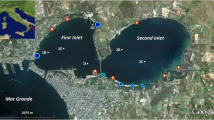Abstract
The shores of the Golden Horn—once most important seaport of the region—represented throughout history a romantic and recreational venue. This tributary to the Bosphorus, however, became seriously polluted with the extensive industrialization and rapid population growth in Istanbul over the past century. Two main tributaries, the Alibeykoy and the Kagithane, dumped both liquid and solid waste from residential areas and industry (small and large-scale) into the Golden Horn. As a result of this pollution, the landward three to four kilometers of the estuary became swamped with sediment. The dominance of anaerobic activity resulted in a highly unpleasant smell, and the shallow depth as one progressed up the bay restricted navigation. In early 1997 The Istanbul Metropolitan Municipality began a dredging operation and gradually diverted all domestic and industrial wastewater discharge from the Golden Horn. Since then there have been remarkable improvements in water quality.
This paper presents the state of eutrophication through the water body of the Golden Horn; parameters such as DO, TKN, NH3-N, NO3-N, the total phosphorus (TP) and dissolved phosphorus (PO4-P), phytoplankton and chlorophyll-a have been were analyzed in samples of water taken from various points in the Golden Horn. The presence of DO and the phytoplankton, both indicators of primary productivity in an aquatic body, has been evaluated in relation to former conditions.
Similar content being viewed by others
References
APHA (American Public Health Association): 1995, Standard Methods for the Examination of Water and Wastewater, 19th edn. Washington, DC.
Chapra, S.C.: 1997, Surface Water Quality Modeling, Mc Graw Hill, U.S.A., p. 528.
Gonullu, M.T., Bayhan, H., Avsar, Y., Arslankaya, E., Kurt, U., Tosun, I. and Apaydın, O.: 2003, ‘A study of organics and their alteration in benthic sediments of Golden Horn’, Fresenius Environ. Bull. 12, 1457–1464.
Jones, Ian S.F.: 2002, ‘Primary Production in the Sulu Sea’, in: Proceedings of the Indian National Science Academy, Earth and Planetary Sciences, September 2002, No. 3, pp. 209–213.
Okus, E., Aslan, A., Tas, S., Yilmaz, N. and Polat, C.: 2001, ‘Distribution of Nutrients and Chlorophyll-a Through the Golden Horn’, in: Proceedings of Haliç 2001 Symposium, May 3–4, 2001, Istanbul, Turkey, pp. 145–152 (in Turkish).
Sorokin, Y.I. and Sorokin, Y.P.: 1996, ‘Plankton and primary production in the Lena River Estuary and in the south-eastern Laptev Sea’, Estuarine, Coastal Shelf Sci. 43(4), 399–418.
Vooys, C.G.N.: 1979, in: B. Bolin, E.T. Degens, S. Kempe, and P. Ketner (eds.), Primary Production in Aquatic Environments, The Global Carbon Cycle, SCOPE 13, The Scientific Committee on Problems of the Environment (SCOPE), Chapter 10.
Wilson, J.G.: 2002, ‘Productivity, fisheries and aquaculture in temperate estuaries’, Estuarine, Coastal Shelf Sci. 55, 953–967.
Author information
Authors and Affiliations
Corresponding author
Rights and permissions
About this article
Cite this article
GÖNÜllÜ, M.T., Avşar, Y., Bayhan, H. et al. Primary Productivity in the Golden Horn. Environ Monit Assess 109, 57–64 (2005). https://doi.org/10.1007/s10661-005-5288-z
Received:
Accepted:
Issue Date:
DOI: https://doi.org/10.1007/s10661-005-5288-z




